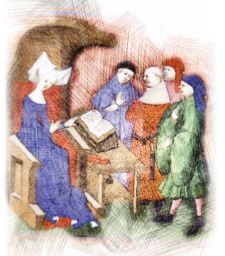
I'm always very excited to find in history courses references to Christine de Pizan, a woman in the 1300s who was the world's first feminist and first professional writer. IMHO, she is under-heralded and too frequently overlooked. My novel A Slender Tether (Fireship Press, 2013), dramatizes her difficult early years that were filled with grief, poverty, and thwarted ambition.
I'm drawn to her because of her hunger to write (which I feel in my gut), her struggle with ambition (a love-hate relationship I know well) and her feeling that she is a "raptor among bluebirds", socially unacceptable for her ferocity (a more autobiographical idea than anything I've ever written before.)
So when The Great Courses Plus included her in their (excellent) course "Warriors, Queens and Intellectuals: 36 Great Women Before 1400"
taught by Joyce E. Salisbury, PhD, Professor Emerita of Humanistic Studies, University of Wisconsin-Green Bay.
Salisbury states that Christine (1364-1430) was "the first professional writer of either gender" and penned more than 40 works [20 books] that were "immediately valued and continue to be read today." But Pizan lived during an incredibly difficult time: France was troubled by plague, famine, The Hundred Years War, and a split papacy. She was witness to the "close of the pre-modern world" and it showed in her work: she relied on reason and learning more than god, wrote in the vernacular, and, most importantly, she championed the value of women at a time when treatises abounded on women's intellectual and moral inferiority.
I first applaud, and then invite you to read my dramatization of her life.
- My novel's section on Christine, "The Raptor Among Bluebirds", opens with Tommaso, her father, facing death and struggling with the difficult position of his family – the foolishness and incapability of his sons, the brilliance of his daughter who lived in a world where an intelligent woman was considered useless, the constant battle between Christine and his wife who insisted Christine not be educated, and his own fumbling inadequacy at stockpiling money for his family's betterment. Pages 4, 9 and elsewhere.
- In 1379 when Christine was 15, she married Etienne du Castel, a happy marriage which is shown in my book on page 14.
- Tomasso, her father, died in 1389, [I had read on the exact day of his astrological prediction] which is shown on page 18.
- Christine's brothers, in what was essentially an abandonment of the family, returned to Italy, leaving behind their mother and a niece, dramatized in my book on page 19.
- Etienne, her husband, died shortly thereafter of a plague, dramatized on page 40.
- This left Christine a 25-year-old widow, supporting three children, her mother and a niece, dramatized in my book on page 47.
- She had read Boccaccio's groundbreaking work Concerning Famous Women, which I dramatize on page 14 as being given to her by her father and husband.
- Things went from bad to worse, in 1392, when the King went mad in the woods and then suffered from periodic episodes of insanity, dramatized in my book on pages 63 and elsewhere.
I don't want to spoil the action in the rest of my novel but there's an (actual) assassination attempt, a documented (but mysterious) bankruptcy, the death of a child, the intervention of a (real life) librarian, and the rise of the book trade. And as frequently as I can, I put lines of Christine's actual poetry into the dialogue.
Thank you, Joyce Salisbury, and other instructors, for keeping Christine's name in the historical record.